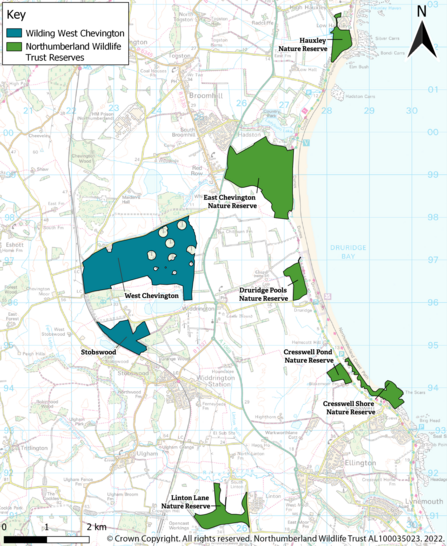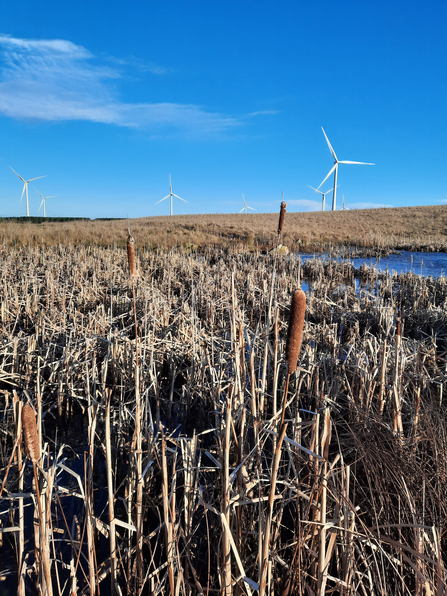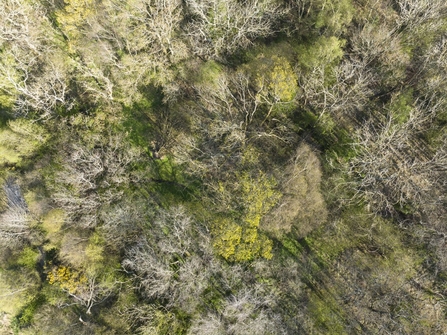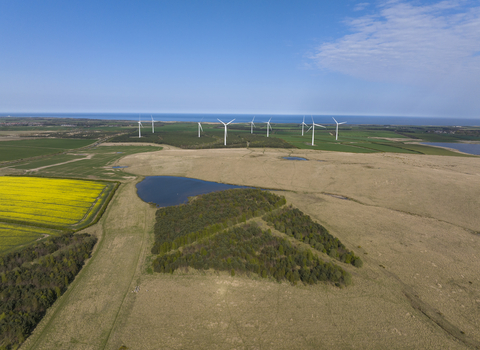A £2 million donation from The Reece Foundation has enabled Northumberland Wildlife Trust to purchase a 327-hectare piece of land at Druridge Bay as part of its bigger plans for a wilder Northumberland.
The large site at West Chevington, near Druridge Bay, was acquired from regeneration specialist Harworth Group plc. It sits atop a former opencast coalmine, like many of NWT’s existing reserves in the area, and will showcase how nature can recover in this manufactured landscape.
The new land at West Chevington will provide opportunities to explore the rewilding concept further, and to work across a much larger scale. It will become a game changer for nature recovery, and will be one of the most ambitious lowland rewilding projects in the north of England, forming an integral part of NWT’s fight against climate change.

Druridge Bay map, image NWT

Image by: Duncan Hutt
What does the project site currently look like?
West Chevington and Stobswood consist of a mosaic of woodland (approx. 108ha), grassland (approx. 110ha) and lower-quality arable land (approx. 109ha), with a system of ponds, ditches and streams. Currently, the land at West Chevington is home to two arable farm businesses, as well as the North Steads Wind Farm. The land at Stobswood supports a beef and lamb farming business. As these are still active farms, we are not encouraging access to the site.
What are our plans?
Our long-term vision for the site is to improve the whole area for wildlife and people. The wilding area will become a game-changer for nature’s recovery, and will be one of the most ambitious lowland rewilding projects in the north of England. We will test a number of ‘rewilding’ methods with the aim of storing carbon, boosting biodiversity and connecting wildlife habitat on an unprecedented scale locally. We want to restore natural processes to reduce climate change impacts, and encourage people to become more engaged with their natural heritage and take action for nature and climate.
Our first priority is to familiarise ourselves with the site, and carry out baseline ecological surveys, as well as working with our farming tenants to consider how their operations will contribute to the future of the project. The findings of our baseline surveys and outcomes discussions with our tenants will inform our plans for the wilding areas.
We will also aim to involve the local community, farmers and landowners across the wider Druridge Bay area to achieve wider gains for nature locally. We have long held a vision to develop a large network of sites for wildlife in Druridge Bay, and the opportunity exists here, perhaps more than in any other part of the county’s lowlands, to develop that network. This whole area has the potential to be a spectacular example of a ‘Living Landscape’, a large-scale network of connected land where wildlife can move freely, adapt and thrive.

West Chevington woodland drone photo, image Jason Friend
Wilding Networks for the North
We are delighted to have hosted a successful Wilding Networks for the North Conference in Newcastle to launch this special project in March 2023. A recording from the day is available below or via our YouTube channel.
Wilding Networks for the North Conference (Part 1)
Wilding Networks for the North Conference (Part 2)
FAQs
Can members of the public visit the wilding area?
No. The site is still home to three working farm business, and to avoid damage to the crops or disturbance to the grazing animals we would ask members of the public to stay away for now. In time, we will develop a plan for access.
What about the existing public rights of way?
The rights of way across the wilding area have been closed since mining was carried out. We will be working with Northumberland County Council, Harworth Estates, Ventient Energy and our other neighbouring landowners on how to reinstate these.
How can I get involved in the project?
All our public events and volunteering opportunities, which will include Wildling West Chevington opportunities when they become available, are listed on our website.
Where can I find out more about the site management plan?
We are currently working on developing a management plan for the site. Information will be available here in due course.
Will there be grazing animals on the site?
Yes. Grazing animals are an important part of any wilding project, and we will be introducing some in due course.
What are the plans for species reintroductions on site?
We plan on introducing species such as water vole and harvest mice. Other missing species that will contribute to the ecosystem will be restored over time.


